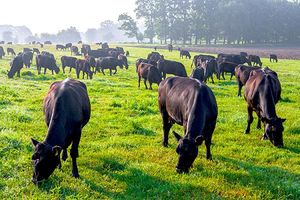Is Pasture, Rangeland, And Forage Coverage For You? Three Factors To Consider
Feed capacity, financial leverage are major variables
Editor’s Note: This is the second of two articles on the Pasture, Rangeland, Forage program. See part one for more of the basics on PRF coverage here.
 Many livestock producers purchase U.S. Department of Agriculture Risk Management Agency (USDA-RMA) Pasture, Rangeland, Forage (PRF) coverage. But how do you know if it will be the right tool to protect you?
Many livestock producers purchase U.S. Department of Agriculture Risk Management Agency (USDA-RMA) Pasture, Rangeland, Forage (PRF) coverage. But how do you know if it will be the right tool to protect you?
1. The impact of climate and the need for rangeland insurance
The climate is typically dry and arid in eastern Oregon where many of ProAg District Sales Manager Todd Kluser’s customers operate. Without irrigation, his customers know a lack of moisture poses a major threat to livestock productivity, so many look to insure their hay and grazing capabilities with PRF.
“If my customers don’t get precipitation at key times, it can have a devastating effect on the future of that ranch. Livestock would be significantly cut because of the lack of feed or hay,” said Kluser. “It’s just paramount that they have coverage.” While he has a diverse customer base, Texarkana, Arkansas-based ProAg Senior District Sales Manager Sam Dickens said as operation size grows and location moves farther west into the arid southern Plains, cattle producers are more likely to purchase PRF coverage.
“The real need in my book is going to be large-scale cattle producers in Texas and Oklahoma, mainly Texas with some in Kansas and Colorado,” Dickens said. “Most of my customers are buying large PRF policies because it’s so dry in these areas.”
2. Policy cost-efficiency factors
A major contributor in deciding whether PRF is a viable option is how closely grazing and forage capacity aligns with the producer’s herd size. If the producer has some “wiggle room” between the two, he or she is less likely to need PRF, given the higher likelihood of having enough forage to support a herd.
“It’s going to be based on what they can afford if they have to replace forage or feed when they lose production because of a lack of moisture,” Kluser said. “If you’re running at maximum capacity, turning cows out and counting on every stitch of hay, you’re going to be more likely to take out a PRF policy.”
3. Financial leverage
Overall, financial leverage is another big variable. Typically, the higher the debt load, the greater the need for a PRF policy, given the additional out-of-pocket expense to sustain a herd in a drought-shortened forage year.
“Some producers have all equipment paid for, while others might be heavily leveraged at the bank,” Dickens said. “If you have a bad year and have to go out and buy silage, can you survive it? If not, you’re going to want top-end coverage. Part of the agent’s job is to ask questions and assess exposure.”
A helpful PRF tool from ProAg
Making a decision on the level of PRF coverage is never a simple decision, but ProAg agents have a valuable resource in the quoting and PRF decision support tools through my.ProAg.com. The interface assembles the data variables, including USDA PRF grid information, essential to making an informed decision, and enables the producer to see potential premium costs before deciding on coverage level and timing.
“It’s not going to be a snap decision,” Kluser said. “Unless ranchers can see where they have a high probability of a loss and can see the benefit from the investment of the premium, they will be hard-pressed to spend the money.”
Added Dickens: “The quoting tool is pretty streamlined, easy-to-use and shows historical info so agents can go back over the last 30 or 40 years within a grid and print out a nice quote sheet. Growers know their premium up front so they can budget for that expense. If worst-case scenario unfolds, they know there will be financial help to get them through it.”
If you’re interested in adding PRF coverage to your operation, start here. If you would like to see how it will directly affect your operation, contact your local ProAg agent or regional specialist.
